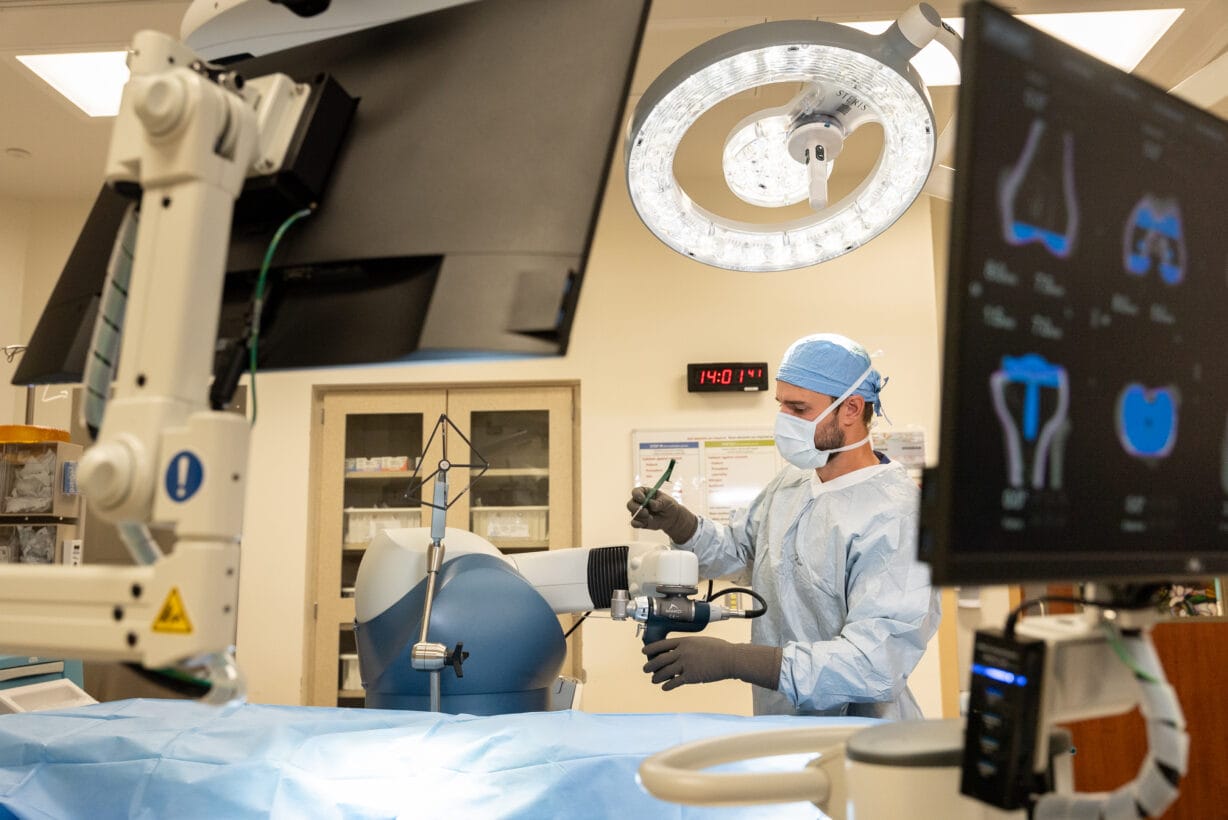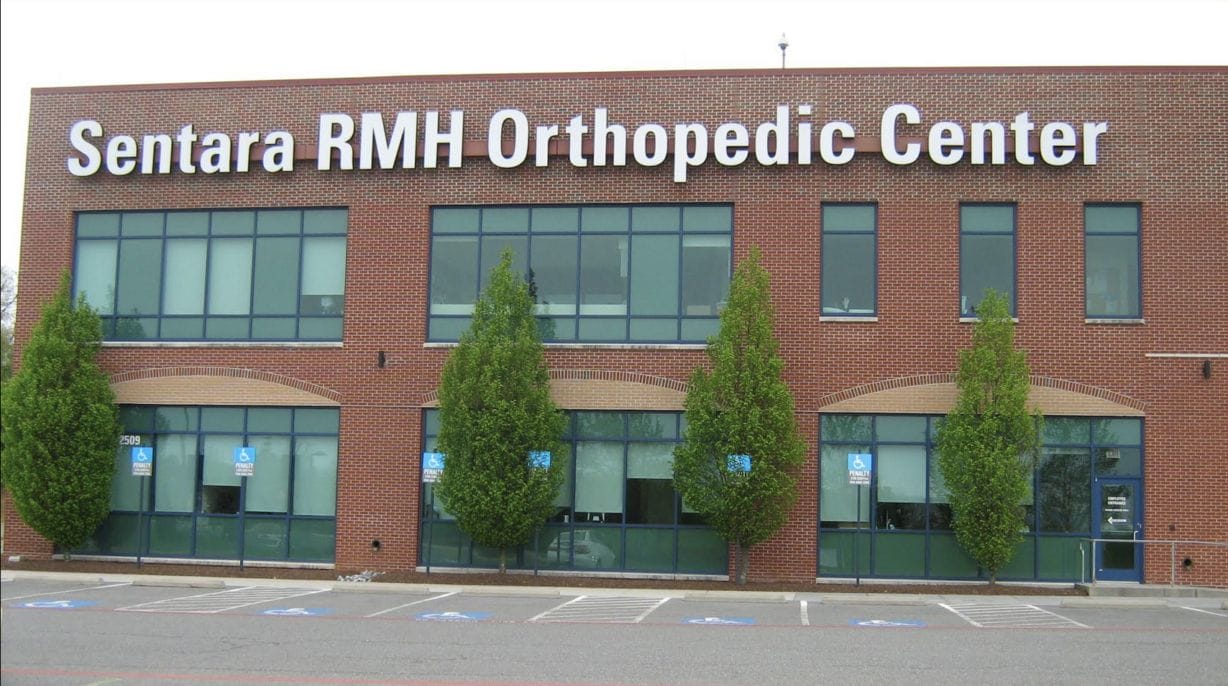
By Stephanie Spernak, contributor
No, robots aren’t doing knee joint replacement surgery at Sentara RMH Orthopedic Center — but they are helping, Dr. Mark Williams told a crowd at a seminar earlier this spring.
Williams, an orthopedic surgeon at Sentara RMH, specializes in knee and hip joint replacement (also called arthroplasty). At the “Orthopedics 101” public seminar Sentara RMH hosted at JMU in March, Williams explained how surgeons are using robotic technology as another tool in the operating room.
A Mako surgical robot, which Sentara RMH recently acquired from medical technology firm Stryker, is used in robotic-assisted surgery, which Williams called the “next level” in knee joint replacement procedures.
Williams began with a playful slide that read “The Robots Are Coming to Replace Your Knee.” He explained, however, that he “is still the surgeon, doing the surgery, not the robot.”
As Williams showed in his slides, the Mako surgical robot is a system of three computerized machines. The system includes a base unit that has one robotic arm attached at the top, a video monitor on a stand with a camera and a guidance cart for the surgeon. The three units are connected by cable to communicate with each other and with the surgeon before and during surgery.
Even with a “robotic arm” at the top of the base unit, no one would confuse the Mako surgical unit with a humanoid robot.
Why robotic devices are helpful for knee surgeries
The human knee is a complex arrangement of bones, cartilage, muscles, tendons, and ligaments that must fit and work together to produce smooth, flexible, pain-free movement.
In a total knee joint replacement, all three compartments where the thigh and shin bones meet are surgically repaired and fitted with an implant. In a partial knee joint replacement, typically only one of the knee joint compartments is damaged and receives an implant made of metal and plastic.
In a knee joint replacement procedure, the surgeon cuts away damaged bone and cartilage at the ends of the leg bones the form the knee joint, Williams said.
Osteoarthritis, which often leads to painful grinding of the bones, is the most common reason for seeking knee joint replacement and about 43% of people with osteoarthritis are 65 or older, according to the Osteoarthritis Action Alliance
Although conventional knee joint replacement is a safe and effective procedure, Williams quoted studies that show about 20% of patients aren’t satisfied with the procedure because they still have chronic pain and stiffness in their “new” knee. While several factors are known to affect post-surgical outcomes for knee joint replacement patients, a surgical procedure that results in knee joint imbalance or limb mal-alignment is one factor that can lead to continued pain.
Robots as tools, not surgeons
Robotic-arm technology, like the Mako surgical robot, can enhance surgical precision and accuracy of implant placement and balance during knee joint replacement, Williams said, by combining pre-surgical planning with 3-D imaging software, intraoperative guidance with dynamic joint balancing, and bone cutting assistance.
Before surgery, a CT scan shows the patient’s knee joint and the surgical robot’s software uses that to develop a high-resolution, 3-D virtual model of the knee joint and projects this model to the video monitors.
Williams said he uses this 3-D imaging to evaluate the knee and surrounding bone structures, disease severity, as well as joint alignment, which is information he said he wouldn’t otherwise have.
The 3-D imaging enables him to create a more precise pre-surgical plan that shows exactly where “to cut bone and where to stop cutting.”
Williams said the 3-D imaging also helps determine the optimal size, placement and alignment of the implant, to “get it exactly right” for that particular patient.
Once surgery begins, Williams said he uses special Mako devices that allow him to “map” the location of the actual knee joint components onto the 3-D image.
Williams said he performs the surgery by guiding the robotic arm that is fitted with special instruments for bone preparation and implant placement. The robotic arm cannot move on its own.
The Mako robotic arm also incorporates feedback sensors, Williams said, called Accustop Technology to ensure that the precision and accuracy of the pre-surgical plan is maintained. These feedback sensors detect deviations from the pre-planned boundaries, Williams said, which alerts the surgeon by “tactile resistance” of the robotic arm.
The AccustopTM technology, he said, “doesn’t let me go outside the boundaries.”
The Mako Surgical Corporation introduced its surgical robot technology in 2006. Stryker bought Mako in 2013, and the Food and Drug Administration approved the Mako robot for knee and hip joint replacement surgery in 2015.
Williams said the Mako surgical robot “has a good track record,” and surgeons worldwide have used it for six years in more than 500,000 procedures.
Before joining Sentara RMH, Williams said he had completed 150 total knee joint replacements, two partial knee replacements and five total hip joint replacements using the Mako surgical robot during his fellowship year in adult reconstruction at the University of Louisville School of Medicine.

Sentara seminars seek to demystify surgeries
Jennifer Smiley-Gill, executive director of business operations at Sentara RMH, told the Citizen by email that the Medical Center hosted the “Orthopedics 101” seminar to share information about innovative technologies and services in specialty care the hospital now offers.
Rosemary Brenner, 80, of Rockingham County, who was at the seminar, said she had been receiving medical treatment for pain and stiffness in both knees, but the treatments have not worked. She said she is now considering surgery to replace her knee joints and is “keeping an open mind about the robot.”
Smiley-Gill said that Sentara RMH offers seventeen types of specialty care services. She said that “in 2023, orthopedic surgery accounted for about 10% of the Sentara RMH overall surgical volume.
Using robotically-assisted surgery for knee and hip joint replacements at Sentara RMH, “gives me confidence in knowing I did the best possible job for every patient,” Williams said.
Thanks for reading The Citizen, which won the Virginia Press Association’s 2022 News Sweepstakes award as the top online news site in Virginia. We’re independent. We’re local. We pay our contributors, and the money you give goes directly to the reporting. No overhead. No printing costs. Just facts, stories and context. We value your support.













